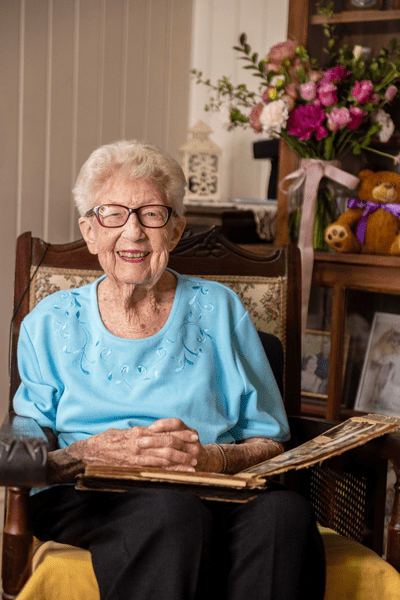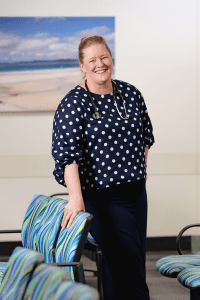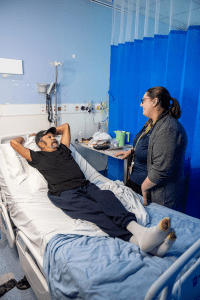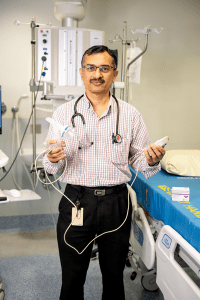A message from the RBWH Foundation
40 years of keeping research strong
Message from RBWH Foundation CEO Simone Garske

“I left Aramac when I was 15, but that has stuck with me—the Royal supported the West, so I support the Royal. My donations are a drop in the bucket, but every dollar counts. Don’t underestimate the importance of that.” Heather Hallam, RBWH Foundation Donor.
For the RBWH Foundation, 2025 will be remembered as a year of celebration—the year we marked a significant milestone in medical and health philanthropy. Our 40th anniversary is also a testament to forty years of Herston innovation and commitment to compassionate care.
Since 1985, the Foundation has existed to build a culture of generosity, anchored in gratitude for the exceptional health services provided by RBWH, STARS and the prestigious Herston Health Precinct research institutes and centres we partner with.
For donor Heather Hallam, the ‘Royal’ has always been a beacon of hope, shining brightly for rural communities in their time of need. For 37 years strong, Heather has donated to research through the RBWH Foundation, counting herself lucky to be a supporter, rather than a recipient of ground-breaking medical care.
Heather’s investment in the future of care is an investment in Metro North’s dedicated and passionate health and medical professionals. Your curiosity and determination to improve patient outcomes ensures research thrives and innovation prospers.
The RBWH Foundation is proud to have distributed $3.9 million across RBWH, STARS and Herston research institutes in FY24. Of that, $1 million directly funded the RBWH Foundation grant strategy, supporting clinician-led life-changing research and patient care innovation. Our Raise it for Redcliffe Hospital initiative distributed close to $200,000.
Highlights of 2024
$84 million distributed in the 40 years since inception
$3.9 million distributed in FY24
Research grants $2,151,822
Patient care initiatives $832,918
Hospital programs $763,592
Wellbeing for hospital staff $130,000
Many of the RBWH Foundation grant projects have an immediate impact; others are laying foundations for the future, building evidence that forms the basis of national grant applications.
In the past year, RBWH Foundation has funded medical and health innovation to tackle weight stigma in pregnancy, support access to healthcare for Aboriginal and Torres Strait Islander patients and deliver innovation in burns pain management. Read more about these health and medical innovations below.

Professor Leonie Callaway, RBWH Women’s and Newborns Service Director of Research
Tackling weight stigma in pregnancy
Professor Leonie Callaway, one of the most cited scientists in the world and winner of the 2022 Women’s Health Australasia Medal of Distinction, has her sights set on making clinical care more compassionate for larger bodied women.
“Weight stigma or discriminating on the basis of body size and shape is the last form of discrimination that appears to be acceptable in healthcare,” said Professor Callaway.
Now developing an RBWH Foundation funded program to reduce the health stigma suffered by pregnant women with larger bodies, Professor Callaway said that ‘fat shaming’ only leads to women avoiding or disengaging from healthcare.
“There is compelling evidence that weight stigma is associated with reluctance to seek health care; it is possible that many of the poor health outcomes experienced by larger bodied women are explained by weight stigma and discrimination, rather than body size.”
Professor Callaway said that ongoing, co-designed consumer research will be critical to improving care for women engaging with health services.

Indigenous patient Bob Lawton with Indigenous Health Liaison Officer Emma Galea
Supporting access to healthcare for Aboriginal and/or Torres Strait Islander patients.
Kate Dickson, Director of RBWH Outpatient Services
This RBWH Foundation grant is enabling the RBWH Indigenous Hospital Liaison Service to ‘wrap a blanket around’ patients and their loved ones who struggle with the cost of attending hospital.
“Financial barriers are one of the main contributing factors as to why our mob don’t come to their appointments. The grant has allowed us to care for people in a practical way – removing that stress,” said Pat Kennedy, RBWH Indigenous Hospital Liaison Service (IHLS) team leader.
Today, Aboriginal and Torres Strait Islander men and women have a life expectancy more than eight years shorter than the general population. That gap increases to more than 12 years for Aboriginal and Torres Strait Islander people in remote areas.
Recognising that RBWH faces significant challenges in providing healthcare services to First Nations patients, the Foundation is playing its part in Closing the Gap by listening, learning, collaborating and working in partnership with Aboriginal and Torres Strait Islander stakeholders.
For the IHLS team, the $20,000 grant eases transport challenges, accommodation costs, and provides emergency food and toiletries.
“Sometimes all we’re giving is $13 or $30 – it can be as little as that, but it might mean someone gets the treatment they need or bringing people with them for much needed support.”

Associate Professor Jayesh Dhanani, RBWH Intensive care specialist
Innovation in burns pain management
Associate Professor Jayesh Dhanani, RBWH Intensive care specialist
An RBWH Foundation funded trial could hold the key to alleviating pain for burns patients, with inhaled sedation branded a ‘game-changer’.
For Associate Professor Jayesh Dhanani, witnessing the impact of ‘excruciatingly painful and distressing’ dressing changes on patients and staff inspired him to seek a better alternative to traditional pain management techniques.
“Inhalation allows the sedative to slowly leach into blood circulation, achieving a good peak level after about five minutes and lasting throughout the dressing change,” Professor Dhanani said.
Patient Karen Harman experienced third-degree full thickness burns to 23 per cent of her body after she was doused in fuel by someone attempting to reignite a backyard firepit. With her Achilles tendon exposed on both ankles and needing extensive skin grafts, Karen said dressing changes were traumatic.
“You’re looking at these awful wounds and with each dressing, you know you’re going to be torn to pieces all over again, as they remove all the bits of dead skin that can prevent healing and cause infection,” Karen said.
The introduction of inhaled medication, she said, had a huge impact.
“Every patient we invited to participate in the trial agreed without hesitation,” Dr Dhanani said.
“We observed some significant benefits. Patients were calmer and more able to tolerate pain, which also improved the speed of the process. In one case, staff were amazed to have a patient singing their way through a dressing change.”
Strategic alignment and accountability
An independent Impact Grants Advisory Panel ensures a transparent, competitive review process for all applications received. The Panel of eight members includes RBWH and STARS executives or their nominated representatives, a First Nations representative and a consumer representative.
Find out more about the RBWH Foundation.

